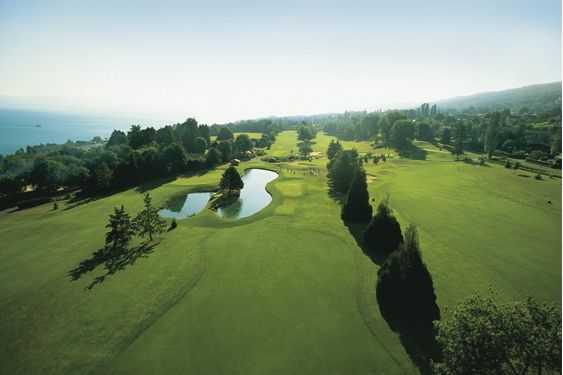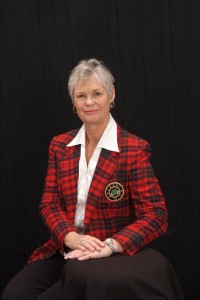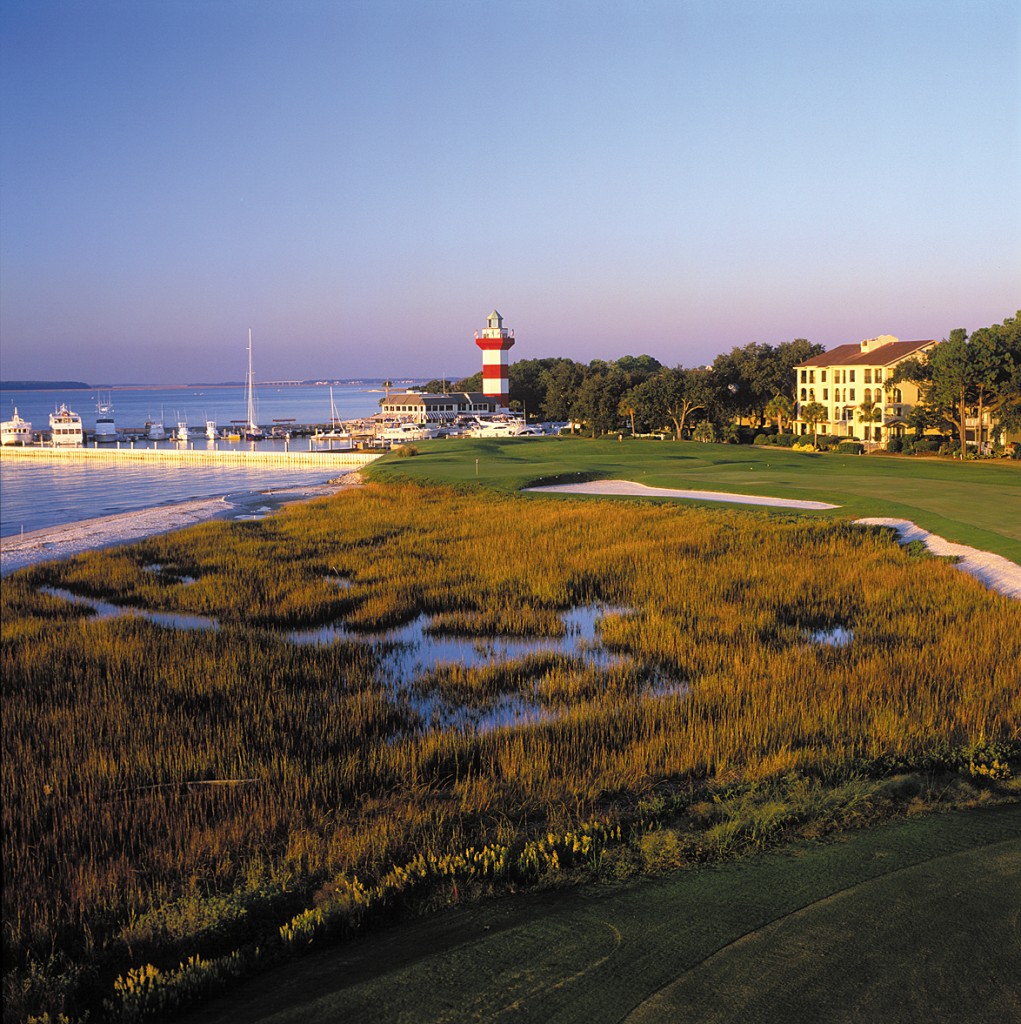In celebration of Mother’s Day [May 3, 2010]—as well as our devotion and respect for moms and women every day of the year—The A Position.com thanks the ladies for their contributions to our lives and to the game.
A few years ago, I took my wife on a whirlwind tour of France. From Bordeaux to Nice, we stayed at many fine hostelries, but only at one did she shed a tear when we left. Looking back, I understand how she felt. Perched on the south bank of Lake Geneva at the foot of the French Alps, Evian Royal Resort, located in Evian-les-Bains, famous for its waters, is the loveliest golf resort on the Continent, a place that exudes an air of enchantment and romance. We stayed at the Hotel Royal, a swank Belle Époque palace that resembles an enormous white steamship moored high above the placid lake. When lights twinkle along the shoreline after dark, when the pure air at 500 meters moistens at dusk and becomes salubrious, the place takes on an intoxication all its own. Hotel Royal and its sister property, Hotel Ermitage, a Savoyard-style chalet slated to reopen in June following a major renovation, are set within a tranquil 42-acre park. Burgundy stone paths wind among century-old trees, small ponds and exquisite gardens. For total relaxation, the resort’s spas offer treatments designed to awaken the senses. Guests can indulge in classic French dishes or opt for “synergetic cuisine” based on energy-enhancing gastronomy. For sport, there’s the Evian Masters Golf Club, a vintage Willie Park, Jr. creation etched into the side of a hill. Annual site of the Evian Masters, a premier women’s tournament, the parkland-style course is a pure delight. When the round is done, players can relax on the alpine-themed, flower-decked terrace of Le Chalet du Golf. Owned by Danone, the yogurt folks who also own Evian mineral water, the company spares no expense to ensure that its prized possession, a place of exceptional beauty and charm, is burnished daily.
—Brian McCallen, brianmccallen.com
For Mother’s Day, lots of guys will be seeking out architecturally “women-friendly courses.” You can spend a lot of time researching this, reading course reviews and ratings, and become an armchair golf course design buff, or you can take my secret shortcut: Play any course designed by Pete Dye. Why? Because Pete Dye’s longtime co-designer is Alice Dye, the only woman past president of the American Society of Golf Course Architects, and the person who has done more for women’s golf than any other. Even though Pete is known as perhaps the toughest designer in the game for men and pros, he and Alice anticipate how women will play their courses and design them accordingly: the Dyes introduced the concept of multiple randomly shaped and separated tee boxes and the choice of 4-6 tees rather than the traditional three. They also hate forced carries, except on par-3s, which are always reachable for women. As Dye told me, “When I build a golf course and she comes around and looks at it and says, ‘How is Mary Smith going to play this hole?’ I listen. Most golf courses I built you can roll it from tee to green, some way or another.”
—Larry Olmsted, larrygolfstheworld.com
Hey, Augusta National! At this club, it’s men who park in the back and face tee time restrictions. The Ladies’ Golf Club of Toronto is the only golf club in North America owned and operated by women. It is certainly unique—and important. Since it opened in 1924, the club’s history has paralleled the progress of women in North America as they earned more rights and respect, and moved into careers and opportunities once denied them. Canadian amateur star Ada McKenzie founded the club so women could play and practice without restrictions and enjoy the full benefits of a private club. The Ladies could be viewed as an anachronism because most clubs today do not have restrictions based on sex. But at the Ladies’, women always feel comfortable. They can enjoy a Stanley Thompson course built expressly for women (it has six par-3s), and network with other influential women. Is it perfect? Maybe not. Fair? Certainly.
—Tim O’Connor, timoconnor.ca
Here’s a Mother’s Day gift for all women who play golf, a tip from one of my favorite teachers, Christina Sieminski, a PGA Class A teaching professional at Turnberry Isle (Aventura, Florida) and Ekwanok CC (Manchester, Vermont). “One thing moms don’t have is time, so I encourage my female students to focus their practice time on quality, not quantity. It’s not about hitting balls for hours on end. Divide your practice sessions evenly, spending half your time on whatever your goal is that day. For example, if you have an hour, spend 15 minutes on putting, 15 minutes on chipping and pitching, and the rest on the long game. And by long game I mean the basics, especially alignment and tempo: If you don’t play regularly, tempo is the first thing to go. So whenever you’re going to practice, make a schedule—something moms are good at—and be very diligent about sticking to it. Remember: Quality over quantity.”
—James A. Frank, jimgolfrank.com
Vicki Martz received a watch after 10 years with the Arnold Palmer Design Company. Now, having completed her 25th year with the firm, she has been given the King’s blessing to step away from full-time work in order to hang out her own shingle at Victoria Martz Golf Design. “Mr. Palmer and [the late] Ed Seay were gender blind, and gave me an opportunity of a lifetime.” She used it well, starting as a drafting technician and gradually heading out on the road with the design team. “They would throw me in the back of the plane and cart me along, giving me more and more responsibility; eventually I was designing my own courses.” Indeed, the mother and grandmother is one of but three women members of the American Society of Golf Course Architects (Alice Dye and Jan Beljan the others). She is the only golf architect appointed to the Board of Trustees of the Environmental Institute for Golf. Sustainability issues will be a focus of her design firm—along with a practiced eye on creating courses that are more women-friendly.
—Tom Bedell, tombedell.com
My mother’s garden and flowerbeds surrounded two USGA regulation putting greens Dad built in our large “sports palace” backyard. A chipping course devised and revised by Parrott offspring wreaked havoc among her prized tomatoes, cukes, roses, and peonies. In our minds, these were hazards to be dealt with accordingly. Mom never complained. She simply shook her head while gazing at mangled vines and broken windows. She was happy we chose to stay home. Mom didn’t play golf: Her supporting role was hauling my three brothers and me to junior golf programs and 25-cent, 9-hole weekday rounds at the local muni during decades of muggy Detroit summers. Before sending us out to battle the links—even in later years—she’d pat our behinds and say, “Get a hole-in-one and one-putt every green!” Maybe we didn’t get the hang of those eternal one-putts (though it’s an excellent thought), but the brothers and I have 10 aces among us. And Dad, after 40 years of playing golf with thousands of aceless par-3’s behind him, finally nabbed his first hole-in-one on May 6, 1985, one year to the day—and pretty much the hour—after Mom died. He added four more in as many years. Thanks, Mom, you were the greatest.
—Janina Parrott Jacobs, www.janinajacobs.com
Old Macdonald promises to be a gift to any golfer who’s enamored by the links setting of the southern Oregon coast, the design work of Tom Doak and Jim Urbina, or the achievements of Charles Blair MacDonald. But moms (and non-mother females alike) will get an extra bonus—truly reasonable tee to green distances. Recent research indicates that the optimal course distance for the average woman golfer is 4,200 yards. Though Old Macdonald is Bandon’s longest course from the black tees, it comes in at 4,280 from the Royal Blues, with a Course Rating of 62.6 and a slope of 104. If my many previous visits to Bandon are any indication, ladies won’t find a plethora of female companionship at the resort, but they will find inspired views of the Pacific and greens the size of Connecticut counties. In 2011, they’ll also find some very good company—Old Macdonald will host the U.S. Women’s Public Links Championship.
—Chris Santella, chrissantella.net
If a female golfer wanted me to escort her someplace enjoyable (and my tax refund had just arrived), I would whisk her to The Phoenician in Scottsdale, Arizona. Other best-for-women venues may earn their stripes by hiring lots of women professionals, creating women-only clinics, or building a 5,000-yard course with 18 downhill tee shots. The Phoenician just has to unlock the front gate and let the ladies in. Its three nines have some length and trouble, but they are visual confections spread out below the resort’s reassuring luxury and Camelback Mountain beyond. Even if she hits into trouble all day, the woman you squire around this layout is ever aware that the resort’s alluring interiors and its seductive, 22,000-square-foot spa await her.
—David Gould, davidlgould.com
What are the LPGA’s prospects in light of Lorena Ochoa’s retirement at the age of 28? Not as bad as they might seem. The LPGA was in a crisis last summer with a dwindling number of tournaments thanks to the overly ambitious plans and poor sponsor relations of former Commissioner Carolyn Bivens, combined with a bad economy. But with Bivens ousted and new boss Michael Whan showing that he’s willing to work with sponsors instead of dictating to them the ship is again headed in the right direction, although there is still a long way to go. Ochoa was a very likeable star, one of the nicest people in golf. She and Annika Sorenstam, who retired a couple of years ago for similar family reasons, have been the face of LPGA golf for the past decade. But if young players like Michelle Wie and Paula Creamer step up (not much pressure there!) and the economy continues to improve, the LPGA has a good chance of shaking its doldrums.
—David Barrett, davidhbarrett.com
It’s hardly original scholarship to ponder our love of the game in the face of all manner of humiliation, but golf actually can occasionally exert a palliative effect that goes beyond just the satisfaction of a few good shots. This writer’s experience coincided not with Mother’s Day, but several months prior, shortly after my mother-in-law had died. Thanks to the generosity of the people at the Maui Visitors Bureau, my wife, Mercedes, and I found ourselves at Kapalua. But Mercedes, while certainly appreciative, remained susceptible to an impossible-to-shake numbness that losing a loved one entails. Fortunately, help arrived in the affable persona of Jerry King, the head professional at Kapalua’s golf academy. Seamlessly combining the antic and the technical, Jerry got the usually indifferent Mercedes really into the game in a way that made all else seem inconsequential. We surrendered to the mesmerizing vistas of the Plantation Course that afternoon and were treated to a surprise rose petal bath by our friends at the Ritz Carlton that evening. And for the rest of the trip, at least, the mood lightened.
—Tom Harack, tomharack.com
Augusta National is known for treating ticket-holders at the Masters well, a trade-off for the decorum it expects of patrons. Augusta National doesn’t stiff them for concessions, it sells shirts and hats at a reasonable price, and according to Robbie Ferreri, a veteran of the Japan Tour and a knowledgeable observer of the global golf scene, the gentlemen running the Masters treat the women in attendance as honored guests. “Augusta National is the most women-friendly golf tournament in the world to attend,” she says. “It pays to be a woman here. The lines to the ladies rooms are no waiting, and the facilities are civil, clean, and staffed with ladies to serve. No outdoor stalls here. It’s the best of the best. Every women should attend one Masters in her golfing life.” So if you’re looking for a special treat for the woman golfer in your life—mom, wife, sister, partner—get in the queue for Masters’ tickets.
—John Strawn, johnstrawn.com
Mother’s Day is a great time to celebrate Alice Dye, not so much for coproducing golf course architecture progeny P.B. and Perry, but for codesigning a portfolio of stellar (and, yes, manly) courses that includes PGA West, Kiawah Island’s Ocean Course, Harbour Town Golf Links, Crooked Stick, Teeth of the Dog (in the Dominican Republic), and the TPC Sawgrass Stadium Course. Next time your wise-ass golf partner calls you “Alice” for leaving a putt short, thank him for the compliment. The old white guys in the American Society of Golf Course Architects were insightful enough to recognize her achievements by electing her their first woman president (she also served as the first female independent director of the PGA of America). We’d like to see Alice deliver a stern talking to—as stern as, say, the green complexes at PGA West—to the old white guys in green jackets at Augusta.
—Jeff Wallach, jeffwallach.com
Women-friendly design, in my opinion, means little when it comes to golf course architecture. Of course, I had the fortune of learning to play golf—and get beat regularly in the process—by Shelly Edwards (née Bonfantine), a good friend who was also a player on the Futures Tour. A point driven home during our first round together, when, after seeing my first tee shot slice onto the driving range, Shelly said, “You can pick the tees and I’ll give you as many strokes per hole as you want.” So, being both unqualified anatomically and having years of proof that having more forward tee boxes doesn’t matter to many women, I asked both Shelly and my wife, Rebecca, what their favorite course is and why. Shelly chose Flint Hills National in Wichita, because, as she says, “It’s challenging” (read: Fun). And Rebecca chose either course at The Boulders in Scottsdale because, as she says, “They have the best on-course Bloody Mary” (read: Fun). See, not much different than the guys.
—Jason Kerkmans, jasonkerkmans.com




